Remember when we were kids and we took every single quarter we had and sunk it into the coin slot at our local arcade? Those were THE. BEST. TIMES. The boom of early 80s saw arcades and pizzerias literally be packed with kids, and it seemed like new video game consoles were being released weekly.
If fact, many of the iconic video game franchises were birthed during that early 80s arcade boom. We played until our hands fell off and we died, only to then be reborn with a shiny Atari or Nintendo NES in our living room.
Sure, a video game console in every home ultimately killed the gathering around a few video game cabinets in the back of a burger joint, but only a darned fool would overlook the importance of these first video games in the history of gaming. Those were halcyon days, and it’s not just nerd nostalgia; the early 80s arcade boom was an important and meaningful period in gaming culture (until around 1984ish).
So, here’s a list of the greatest arcade cabinets in video game history. Typically, Nerds on Earth rolls with lists of 7, but I’m the boss of me, so I’m doubling down on this list.
The 14 Greatest Arcade Cabinets In Video Game History
14. Moon Patrol
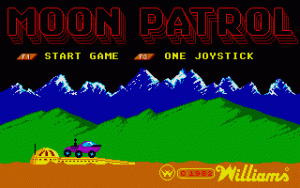 Moon Patrol introduced some new things in 1982. The moon lander fired to the right, but it also fired straight up. As you jumped or slowed down to avoid craters and rocks, you were also firing at UFOs over head.
Moon Patrol introduced some new things in 1982. The moon lander fired to the right, but it also fired straight up. As you jumped or slowed down to avoid craters and rocks, you were also firing at UFOs over head.
Moon Patrol also had a continue feature, which allowed players to start the game from a checkpoint rather than have to start all over. A pocket full of quarters allowed players to complete the game, but many lamented this, as it lessened to prestige of putting in your 3 initials for a high score. It took me just over half a roll of quarters to beat this one.
Moon Patrol Specs | Game Play Video
13. Tempest
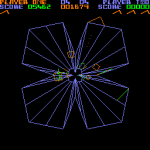 Tempest was originally meant to be a 3D remake of Space Invaders, but versions had problems, so a new design emerged. The game takes place on a playfield which is viewed from one end and is divided into a dozen or more segments or lanes. A rotary knob controls a “claw” spaceship that zips along the edge of the playfield, moving from segment to segment.
Tempest was originally meant to be a 3D remake of Space Invaders, but versions had problems, so a new design emerged. The game takes place on a playfield which is viewed from one end and is divided into a dozen or more segments or lanes. A rotary knob controls a “claw” spaceship that zips along the edge of the playfield, moving from segment to segment.
Enemies swirl around, then enter the playfield and move toward the player. The objective of Tempest is to survive as long as possible, clearing the screen of enemies that have landed on the playing field. When all enemies in a level are destroyed, the player “warps” to the next level.
Tempest Specs | Game Play Video
12. Asteroids
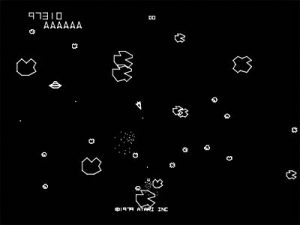 Asteroids was actually released by Atari in November 1979. Player control a spaceship in an asteroid field (Duh!). The object of the game is to shoot and destroy asteroids (and flying saucers) while not colliding with anything, thereby meeting your doom.
Asteroids was actually released by Atari in November 1979. Player control a spaceship in an asteroid field (Duh!). The object of the game is to shoot and destroy asteroids (and flying saucers) while not colliding with anything, thereby meeting your doom.
With its addictive gameplay, Asteroids was one of the first major hits of the golden age of arcade games, selling over 70,000 cabinets. While it was never my jam, you can’t argue against its importance in video game history.
Asteroids Specs | Game Play Video
11. Missile Command
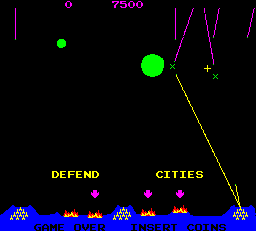 Missile Command, on the other hand, was my jam. In Missile Command, players must defend six cities from destruction as they are attacked by an endless assault of missiles.
Missile Command, on the other hand, was my jam. In Missile Command, players must defend six cities from destruction as they are attacked by an endless assault of missiles.
The game was played with a trackball that moved a set of crosshairs across the sky in order to shoot down the missiles before they reached the cities. The game ended when all six cities were destroyed, the game becoming a contest to a contest to see how long the player can survive.
Anyone who has ever played Missile Command in an arcade will never forgot the experience and sound of the trackball and they whooshed the crosshairs all across the screen.
Missile Command Specs | Game Play Video
10. Joust
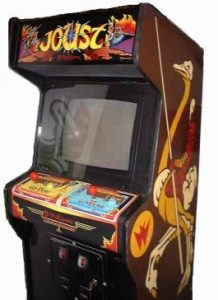 I didn’t discover this game until the Atari 2600, but boy did I ever play the heck out of it. Joust is a platformer where the player controls a knight on a flying ostrich. Of course.
I didn’t discover this game until the Atari 2600, but boy did I ever play the heck out of it. Joust is a platformer where the player controls a knight on a flying ostrich. Of course.
Tapping the button flapped the ostrich’s wings, allowing the player to fly the ostrich and maneuver it with the joystick in order to knock the other player (a blue knight on a stork) of his mount.
It’s a fantastic game, even if my friend JD did routinely get the best of me when we played.
Spoiler Alert: Joust was an interesting part of the book Ready Player One.
9. Q*Bert
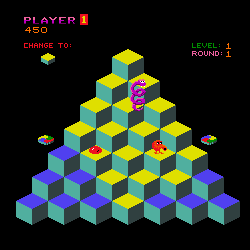 Fun fact: I had a buddy in High School that we called Q*Bert, simply for the fact that he had a huge head, which reminded us of the character from this arcade classic. That’s pals for you.
Fun fact: I had a buddy in High School that we called Q*Bert, simply for the fact that he had a huge head, which reminded us of the character from this arcade classic. That’s pals for you.
Q*bert was a 2D puzzle game, which was developed by Gottlieb in 1982 and went on to become their most successful title. The game used isometric graphics to create a pseudo-3D effect, and players used a joystick to make Q*Bert hop around the board to change the color of cubes while also avoiding enemies.
Q*bert became known for his “swearing”, which was really an incoherent sound effect and a speech balloon of nonsensical characters. Not surprisingly, Q*bert was briefly named Snots And Boogers and @!#?@! during development.
Q*Bert Specs | Game Play Video
8. Centipede
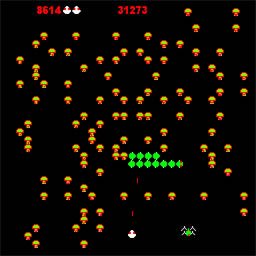 If I would’ve taken all the quarters I spent on this game and invested them in an IRA yielding compound interest, I would be a multi-millionaire by now, only to then take that money to buy a vintage Centipede cabinet for my mansion.
If I would’ve taken all the quarters I spent on this game and invested them in an IRA yielding compound interest, I would be a multi-millionaire by now, only to then take that money to buy a vintage Centipede cabinet for my mansion.
Centipedes, spiders, and scorpions wind their way down the playing field through a field of mushrooms. The player moves about the bottom area of the screen with a trackball and fires laser shots at the rapidly approaching creepie-crawlies.
Hey, that description might not sound like much, but the game is awesome.
Centipede Specs | Game Play Video
(Click below for ‘Part 2’)

